现在分词与过去分词作宾语补足语的区别
非谓语动词 (4)

非谓语动词一.概念非谓语动词就是指在句中不能单独作谓语的动词,并且不受主语的人称或数的制约。
非谓语动词可分为不定式,动名词和分词(现在分词和过去分词)。
二.基本特点:三种非谓语动词都具有动词的特征,虽然它们没有人称和数的变化,但是它们都能带自己的状语或有时跟宾语。
它们都有各自的特征:不定式具有名词、形容词和副词的特征,在句子中能够做主语、宾语、表语、补足语或状语。
分词具有形容词和副词的特征,在句子中能够做定语、表语、状语或补足语等;动名词具有名词的特,在句子中能够做主语、宾语、表语等;动词不定式1.动词不定式的基本结构to + 动词原形。
2.动词不定式的形式时态主动态被动态一般式to do to be done实行式to be doing完成式to have done to have been done完成实行式to have been doingEg.1.John said that he had run in order to catch the bus. (一般式的主动态)2:He hated to be misunderstood by others. (一般式的被动态)3:He pretended to be listening attentively. (实行式)4:He intended to have told you that. (完成式主动态)5:This work of art seemed to have been created several centuries ago.(完成式的被动态)6:We’re happy to have been working with yo u. (完成实行式)3. 动词不定式的用法,在句中可作主语、表语、宾语、定语、状语等(1)作主语。
例如:To see you is always a pleasure.To make money is not the only purpose of our life.在很多情况下,常用it 来充当动词不定式的形式主语。
英语现在分词和过去分词用法异同

make
简析:首先,根据语法分析可知,待选部分在整个句中应作状语;
再根据 European football 对于 make 来说应是主动关系,即欧
洲足球使之本身成为一项最受世人欢迎的运动。因此,该题应选A。
2.____ a reply, he decided to write again.
A. Not receiving
-They got very ____.
分词作宾语补足语
共同点:分词在复合宾语中可作宾语补 足语,对句子的宾语起补充或说明作用。 不同点:分词作宾语补足语时,句子的 宾语就是该分词的逻辑主语。但现在分 词与其逻辑主语之间是主动关系,所表 示的动作一般与句中谓语动词所表示的 动作同时发生;而过去分词则表示被动 关系,所示动作一般发生在谓语动词之 前或同时发生。
简析:该题应选A。测试过去分词作后置定语表达被动,等于定语
从句 who were invited
5.Most of the artists ____ to the party were from South
Africa.
A. invited B. to invite C. being invited D. had
B. Receiving not
C. Not having received
D. Having not
received
简析:该题应选C。 测试非谓语动词的否定式是在其前直接加
not 。若动作发生在主句动作之前时用非谓语的完成式。
3.The visiting Minister expressed his satisfaction with the
1.This news sounds ____.
现在分词与过去分词的区别与用法解析
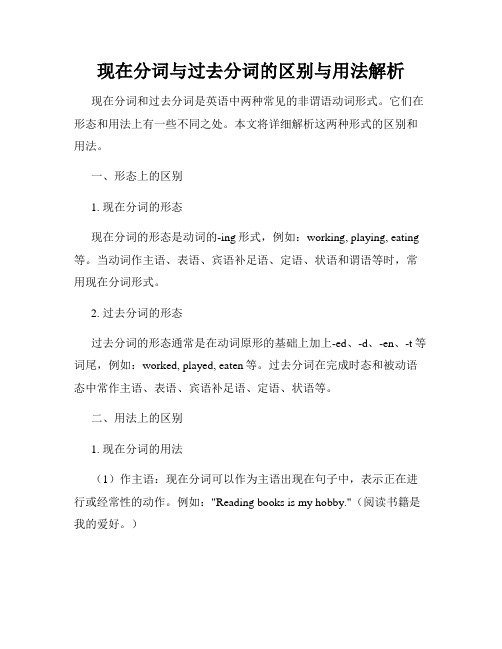
现在分词与过去分词的区别与用法解析现在分词和过去分词是英语中两种常见的非谓语动词形式。
它们在形态和用法上有一些不同之处。
本文将详细解析这两种形式的区别和用法。
一、形态上的区别1. 现在分词的形态现在分词的形态是动词的-ing形式,例如:working, playing, eating 等。
当动词作主语、表语、宾语补足语、定语、状语和谓语等时,常用现在分词形式。
2. 过去分词的形态过去分词的形态通常是在动词原形的基础上加上-ed、-d、-en、-t等词尾,例如:worked, played, eaten等。
过去分词在完成时态和被动语态中常作主语、表语、宾语补足语、定语、状语等。
二、用法上的区别1. 现在分词的用法(1)作主语:现在分词可以作为主语出现在句子中,表示正在进行或经常性的动作。
例如:"Reading books is my hobby."(阅读书籍是我的爱好。
)(2)作定语:现在分词可以修饰名词作定语,常表示主动、进行或经常性的动作。
例如:"The running water is very clear."(流动的水非常清澈。
)(3)作宾语补足语:现在分词可以作及物动词的宾语补足语,表示正在进行或经常性的动作。
例如:"I saw him painting the house."(我看见他正在刷房子。
)2. 过去分词的用法(1)作主语:过去分词可以作为主语出现在句子中,表示完成的动作或状态。
例如:"Broken glass covered the ground."(破碎的玻璃铺满了地面。
)(2)作定语:过去分词可以修饰名词作定语,表示被动或完成的动作。
例如:"The lost key has been found."(丢失的钥匙已经找到了。
)(3)作宾语补足语:过去分词可以作及物动词的宾语补足语,表示完成的动作或状态。
现在分词做宾语补足语

现在分词做宾语补足语现在分词在句子中可用作宾语补足语,其结构为:主语+谓语+宾语+现在分词(即宾语补足语)使用此结构要特别注意:句子中的宾语和宾语补足语在逻辑上是主动关系,并不是所有的动词都可以跟宾语加现在分词作宾语补足语掌握现在分词作宾语补足语的结构要注意下面的五点一感官动词+宾语+现在分词,现在分词做宾语补足语,表示动作正在进行例如:He saw her working in the garden.他看见她正在花园里干活分析:He在句子中做主语,saw作谓语,her作宾语,划线部分在句子中作宾语补足语请看下面的句子,working in the garden宾语补足语I heard a bell ringing.我听见铃在响I could feel the wind blowing on my face.我能感觉至U风吹着我的脸高中范围内,适用于感官动词+宾语+现在分词的结构,现在分词作宾语补足语常用的动词有:feel, find, hear, notice, observe, see, watch 等在listen to和look at后面也可跟宾语+现在分词(即宾语补足语)例如:Sometimes she would listen to him playing the saxophone. 有时她会听他吹奏萨克斯管She looked at him waiting there.她瞧着他等在那里二使役动词+宾语+分词,现在分词在句子中作宾语补足语例如:His question has set me thinking.他的问题让我深思分析:His question在句子中做主语,has set作谓语,me 作宾语,划线部分在句子中作宾语补足语请看下面的句子,thinking做宾语补足语The arrival of the police sent the robbers running away quickM警察的到来使强盗们四处逃窜The peasants had the tractor working day and night at the harvest time.农忙时,农民们让拖拉机夜以继日地干活The captain got the soldiers moving towards the front after a short rest.休息片刻之后,上尉让士兵们开始朝前线行进起来高中范围内,适用于使役动词+宾语+现在分词的结构,现在分词在句子中作宾语补足语常用的动词有:make ,get,have, keep, leave, send, set等三上述两种结构可变为被动形式例如:He was found lying on the floor.有人发现他躺在地上分析:He在句子中做主语,was found作谓语,使用了被动语态,lying on the floor做宾语补足语请看下面的句子,划线部分在句子中作宾语补足语He was seen sitting in a caf 6.有人看见他坐在一家咖啡馆里The papers were left lying around.文件散落了一地四现在分词不定式作宾语补足语的区别feel,find,hear,notice,observe,see,watch 等感官动词,既可以跟现在分词也可以跟不带to的不定式作宾语补足语现在分词作句子中的宾语补足语,表示动作正在进行;不带to 的不定式作句子中的宾语补足语,表示动作的完成试比较下面句子:He saw her working in the garden.(She was working in the garden.)他看见她在花园里干活He saw her enter the room.(She entered the room.)他看见她走进屋子使役动词get,have既可以跟现在分词也可以跟不定式作宾语补足语get sb to do/have sb do sth表示使/让/叫某人去做某事,侧重动作的结果;have sb/sth doing表示使/让某人/ 物持续地做某事,侧重动作的持续;get sb/sth doing表示使某人/物开始行动起来,侧重动作的开始试比较下面的句子:Mother had me go to the shop and buy some salt.母亲让我到商店买一些盐I cant get him to stop smoking.He wont listen to me.我不能使他戒烟他不听我的话The mother had the boy cleaning the room the whole afternoon.(母亲让这个男孩整个下午清理房间)I cant get the car starting.(我不能把车发动起来)五现在分词有时用被动形式作宾语补足语,其结构为动词+ 宾语+being done例如:I saw him being carried away on a stretcher.我看见他被人用担架抬走分析:I在句子中做主语,saw作谓语,him作宾语,划线部分在句子中作宾语补足语请看下面的句子,划线部分在句子中作宾语补足语One could hear all kinds of things being discussed there.你可以听到那里在谈论的问题五花八门,无所不有高中范围内,适用于动词+宾语+being done的结构,现在分词作宾语补足语常用的动词有:feel, find, hear, notice, see, watch 等练习:选择最佳答案1 .---Why did you go back to the shop---I left my friend there.(2002上海)A.waitingB.to waitC.waitD.waits2 .A cook will be immediately fired if he is found ___ in the kitchen.(2003北京春)A.smokeB.smokingC.to smokeD.smoked3 .He looked around and caught a man ___ his hand into the pocket of a passenger.(2004北京春)A.putB.to be puttingC.to putD.putting4 .Dont leave the water ___ while you brush your teeth.(2004天津)A.runB.runningC.being runD.to run答案:1.A 2.B 3.D 4.B★过去分词作宾语补足语请看一道高考题:The murderer was brought in, with his hands behind his back.A. being tiedB. having tiedC. to be tiedD. tied分析:本题考查过去分词在with的复合结构中做宾语补足语的用法。
非谓语动词之现在分词和过去分词

现在分词与过去分词的区别:
1.语态上:现在分词表主动,过去分词表被动 Do you know the woman talking to Tom? The soldier killed in the war was a doctor.
2. 时态上:现在分词表进行,过去分词表完成 Developing country发展中国家 Developed country 发达国家
2. SSeeeeing from the hill, the city is more beautiful.
3. HHeeaattiendg , water will boil.
We must do a lot of practice.
4. Getting there, the door was found opened.
If they had been given more
attention
Being so angry, he couldn’t go to sleep.
Because he was so angry
They came into the classroom, singing and laughing.
Grammar
非谓语动词 之
现在分词和过去分词
分词:Participles
一 分词的概述
1. 分词是“非谓语动词”的另一种形式,它有两种形式: 现在分词(Present Participle)和过去分词(Past Participle)。 2. 现在分词:doing
过去分词:done
3.分词在句中起形容词和副词的作用。在句中 作表语、定语状语和宾语补足语。
The bridge built last month needs repairing. 上个月建造的那座桥需要修理。
现在分词与过去分词的差别
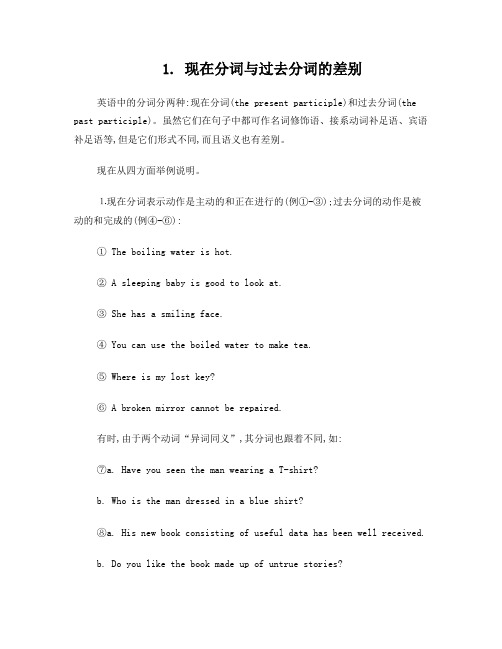
1. 现在分词与过去分词的差别英语中的分词分两种:现在分词(the present participle)和过去分词(the past participle)。
虽然它们在句子中都可作名词修饰语、接系动词补足语、宾语补足语等,但是它们形式不同,而且语义也有差别。
现在从四方面举例说明。
⒈现在分词表示动作是主动的和正在进行的(例①-③);过去分词的动作是被动的和完成的(例④-⑥):① The boiling water is hot.② A sleeping baby is good to look at.③ She has a smiling face.④ You can use the boiled water to make tea.⑤ Where is my lost key?⑥ A broken mirror cannot be repaired.有时,由于两个动词“异词同义”,其分词也跟着不同,如:⑦a. Have you seen the man wearing a T-shirt?b. Who is the man dressed in a blue shirt?⑧a. His new book consisting of useful data has been well received.b. Do you like the book made up of untrue stories?⒉在语义上,现在分词和过去分词反映的心理状态不同。
前者有“令人……”的含义(见例⑨);过去分词则有“感到……”的意思(见例⑩):⑨ The soccer match last night was thrilling.(令人紧张)⑩ The soccer fans were delighted.(感到高兴)其他例子有:● amazing: amazed● annoying: annoyed● boring: bored● confusing: confused● surprising: surprised● terrifying: terrified试比较11a和b以及12a和b:11a. This is the most confusing system I have ever seen.11b. The children will get confused if asked to learn too much at a time.12a. David came with some surprising news.12b. All were surprised at Sam’s sudden resignation.⒊在作宾语补足语时,如果宾语是有关分词逻辑上的主语,就用现在分词,如 :13. The teacher found a student dozing off.14. Don’t keep the visitor waiting.如果宾语和有关分词有“动词+宾语”关系,那么这个分词就要是过去分词了,如:15. Where did you get your book printed?16. You should have your office whitewashed.在13里,正在打瞌睡的是宾语“a studen t“;在14里,宾语是“the visitor”。
高考英语不定式现在分词和过去分词作宾补的区别

高考英语不定式、现在分词和过去分词作宾补的区别当宾语与作宾补的动词在逻辑上是主动关系时,用不定式(未来或全过程)或现在分词(正在进行或一直处于某种状态);当宾语与作宾补的动词在逻辑上是被动关系时,用过去分词。
现根据不同动词的不同用法分述如下,请在下列各例句中仔细体会不定式、现在分词或过去分词作补足语的区别。
■通常用带to的不定式作宾补的动词这类动词很多,常见的有:ask, invite, tell, want, encourage, wish, expect, beg, request, require, advise,order, force, cause, allow, permit, forbid, warn, remind, teach, send, call on, wait for, wouldlike / love / prefer等表示劝请、要求类动词后,用带to的不定式作宾补。
如:1. My advisor encouraged ________ a summer course to improve my writing skills. (北京卷)A. for me takingB. me takingC. for me to takeD. me to take【分析】答案选D。
encourage sb. to do sth. 鼓励某人做某事。
2. The teacher asked us ________ so much noise. (北京卷)A. don’t makeB. not makeC. not makingD. not to make【分析】答案选D。
即ask sb. not to do sth. 叫某人不要做某事。
3. The boy wanted to ride his bicycle in the street, but his mother told him ________. (全国卷)A. not toB. not to doC. not do itD. do not do【分析】答案选A。
现在分词和过去分词的用法异同

A. followed B. following C. to be followed D. being followed
简析:首先,根据语法分析可知,句子后半部分是一个作定语、修
饰 noise 的分词短语;再根据句意“一阵闪电之后,接着就是一声巨
响。”可知,巨响应是主动,紧接在闪电之后的。因此,该题应选B。
-They got very ____.
A . excite B . excited
C . excitedly D . exciting
简析:该题应选B。测试他们被那出新戏所打动。
第7页,本讲稿共18页
三、分词作宾语补足语 共同点:分词在复合宾语中可作宾语补足 语,对句子的宾语起补充或说明作用。
不同点:分词作宾语补足语时,句子的宾语就 是该分词的逻辑主语。但现在分词与其逻辑主语之 间是主动关系,所表示的动作一般与句中谓语动词 所表示的动作同时发生;而过去分词则表示被动关 系,所示动作一般发生在谓语动词之前或同时发生。
不定式todo分词动名词ing过去分词ed现在分词inging形式ed分词现在分词和过去分词的用法异同历来是学习中的难点和高考测试的重点
现在分词和过去分词的用法异 同
第1页,本讲稿共18页
现在分词和过去分词的用法异同历来是学习中 的难点和高考测试的重点。众所周知,两种分词的 区别很多,但它们之间的根本区别是:
据 European football 对于 make 来说应是主动关系,即欧洲足球使之本 身成为一项最受世人欢迎的运动。因此,该题应选A。
2.____ a reply, he decided to write again.
A. Not receiving
B. Receiving not
现在分词和过去分词
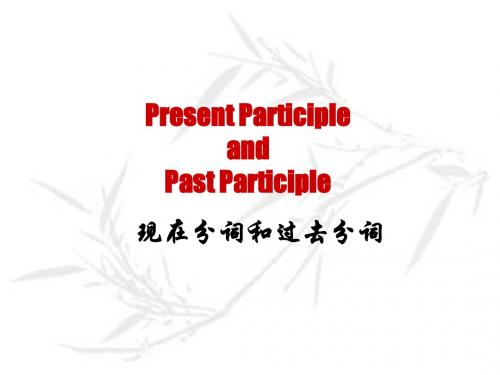
把下列句子合并成一句并把动词改成其分词形式:
1) There were a lot of people who were standing there. There were a lot of people standing there. 2) I saw him. He was listening to the radio. I saw him listening to the radio. 3) Many people are looking for the treasure which is hidden. Many people are looking for the hidden treasure. 4) When Mr Chen stayed in China, he felt very happy. Staying in China, Mr Chen felt quite happy. 5) After she had stayed in China for a long time, Miss Li came to love it. Having stayed in China for a long time, Miss Li came to love it.
Having finished the course, I had an exam.
Participle (phrases) used
as
adverbial
分词做状语
1.时间状语
Hearing the bell, the students went into the classroom
=When the students heard the bell, they went into the classroom.
现在分词与过去分词的用法
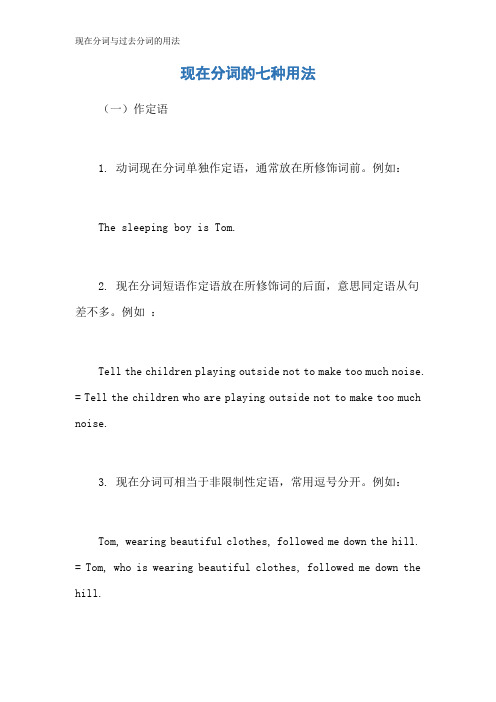
现在分词的七种用法(一)作定语1. 动词现在分词单独作定语,通常放在所修饰词前。
例如:The sleeping boy is Tom.2. 现在分词短语作定语放在所修饰词的后面,意思同定语从句差不多。
例如:Tell the children playing outside not to make too much noise. = Tell the children who are playing outside not to make too much noise.3. 现在分词可相当于非限制性定语,常用逗号分开。
例如:Tom, wearing beautiful clothes, followed me down the hill. = Tom, who is wearing beautiful clothes, followed me down the hill.4. 有时现在分词可以和副词或名词构成复合词作定语。
例如:This is an English-speaking country.(二)作表语现在分词作表语多表示主语的特征。
如amusing, discouraging, puzzling, refreshing, astonishing, exciting 等。
例如:The story is moving.(三)现在分词在句中作宾语补足语,这时现在分词和前面的宾语有逻辑上的“主表”关系或“主谓”关系。
例如:We all found his equipment interesting. (主表关系)I saw Mary going upstairs then. (主谓关系)(四)作状语现在分词作状语,其逻辑主语一般是句中的主语,如果不是,需在V-ing 形式前加名词或代词主格作逻辑主语。
1. 作原因状语,相当于原因状语从句。
例如:Being ill, Mary didn't come to school yesterday.2. 作时间状语,相当于时间状语从句。
过去分词解析考研过去分词的应用和例句

过去分词解析考研过去分词的应用和例句过去分词解析:考研过去分词的应用和例句过去分词是英语中的一种非谓语动词形式,它可以用来修饰名词或作为动词短语的一部分。
在考研英语中,过去分词的应用非常广泛,考生需要熟练掌握其用法和相关例句。
本文将对考研过去分词的应用进行详细解析,以帮助考生更好地理解和运用。
一、过去分词作定语1. 过去分词作定语修饰名词时表示名词所具有的性质或状态,通常位于名词之前。
例句:- The broken window needs to be repaired.(这扇破碎的窗户需要修理。
)- The stolen car was found abandoned in the woods.(这辆被盗的汽车在树林里被发现了。
)2. 过去分词作定语还可以构成一些固定短语,表达特定的含义。
例句:- a well-known writer(一个著名的作家)- a thought-provoking movie(一部发人深省的电影)二、过去分词作状语1. 过去分词作状语可以表示时间、原因、条件、方式等,一般放在句首或句末。
例句:- Walking along the river, she enjoyed the beautiful scenery.(她边河边散步,欣赏着美丽的风景。
)- Having finished his work, he went home.(他完成工作后回家了。
)2. 过去分词作状语时,常和连词“when”、“while”、“after”等连用,以表示时间关系。
例句:- When asked about his opinion, he remained silent.(当被问及他的观点时,他保持沉默。
)- While reading the book, I came across an interesting passage.(在读这本书的时候,我遇到了一段有趣的文字。
)三、过去分词作宾语补足语1. 过去分词常常作及物动词的宾语补足语,表示完成的动作或被动的动作。
现在分词

现在分词一、现在分词的定义现在分词是动词的另一种非限定形式。
它兼有动词、副词和形容词的特征。
可以带宾语或受状语修饰。
现在分词和宾语或状语一起构成现在分词短语。
二、现在分词的基本形式现在分词是在动词原形加词尾ing构成。
现在分词有一般式和完成式,及物动词的现在分词有主动和被动态。
其形式如下:1.现在分词的时态现在分词的主动式的一般式和完成式。
一般式用来指和谓语动词所表示的动作同时发生的行为;完成式(having + 过去分词)用来指在谓语动词所表示的动作之前发生的动作。
如:Being a student, he was interested in books.Having studied in university for 3 years, he knows the way very well.2.现在分词的语态现在分词的被动式的一般式和完成式。
现在分词的主动式表示分词与句子主语之间是主动关系。
当句子的主语是分词动作的承受者时,分词与句子主语时被动关系,分词用被动语式;如果强调分词的动作先于谓语的动作,就用分词完成式被动形式。
如:The question being discussed is important.Having been criticized by the teacher, Li Ming gave up smoking.【注】:being done 不能作状语having been done 不能作定语四、现在分词的句法功能分词不管充当什么成分,都和所修饰的名词或者代词或者句子的主语形成主谓关系。
1.作定语分词短语作定语时,分词短语放在被修饰的名词之后;单个分词作定语时,放在被修饰的名词之前。
相当于定语从句。
如:The man standing by the windows is our teacher. (standing 和所修饰的man形成主谓关系) =who is standing by the window.In the following years he worked even harder.=in the years that followed.现在分词在作定语时,注意分词所表示的动作发生的时间。
现在分词及过去分词的用法

现在分词的七种用法〔一〕作定语1.动词现在分词单独作定语,通常放在所修饰词前。
例如:The sleeping boy is Tom.2.现在分词短语作定语放在所修饰词的后面,意思同定语从句差不多。
例如:Tell the children playing outside not to maketoo much noise. =Tell the children who are playing outside not to make too much noise.3.现在分词可相当于非限制性定语,常用逗号分开。
例如:Tom, wearing beautiful clothes, followed me down the hill.=Tom, who is wearing beautiful clothes, followed me downthe hill.4.有时现在分词可以和副词或名词构成复合词作定语。
例如:This is an English-speaking country.〔二〕作表语现在分词作表语多表示主语的特征。
如amusing, discouraging, puzzling, refreshing, astonishing, exciting等。
例如:The story is moving.〔三〕现在分词在句中作宾语补足语,这时现在分词和前面的宾语有逻辑上的“主表〞关系或“主谓〞关系。
例如:We all found his equipment interesting. (主表关系)I saw Mary going upstairs then. (主谓关系)〔四〕作状语现在分词作状语,其逻辑主语一般是句中的主语,如果不是,需在 V-ing 形式前加名词或代词主格作逻辑主语。
1.作原因状语,相当于原因状语从句。
例如:Being ill, Mary didn't come to school yesterday.2.作时间状语,相当于时间状语从句。
(英语语法)现在分词、过去 分词和动名词的用法
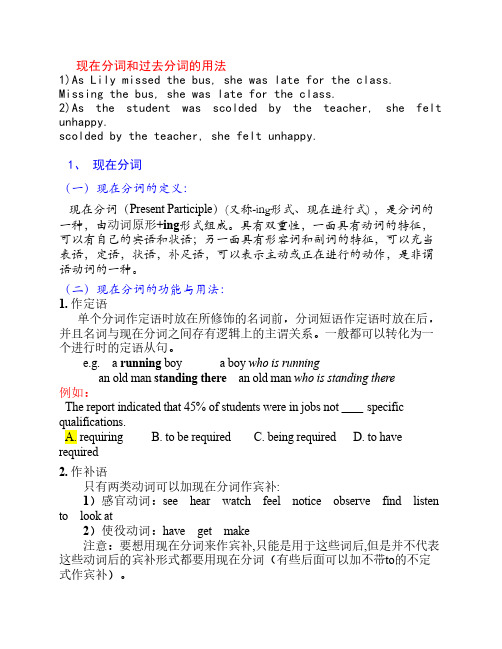
现在分词和过去分词的用法1)As Lily missed the bus, she was late for the class. Missing the bus, she was late for the class.2)As the student was scolded by the teacher, she felt unhappy.scolded by the teacher, she felt unhappy.1、 现在分词(一)现在分词的定义:现在分词(Present Participle)(又称-ing形式、现在进行式) ,是分词的一种,由动词原形+ing形式组成。
具有双重性,一面具有动词的特征,可以有自己的宾语和状语;另一面具有形容词和副词的特征,可以充当表语,定语,状语,补足语,可以表示主动或正在进行的动作,是非谓语动词的一种。
(二)现在分词的功能与用法:1. 作定语单个分词作定语时放在所修饰的名词前,分词短语作定语时放在后,并且名词与现在分词之间存有逻辑上的主谓关系。
一般都可以转化为一个进行时的定语从句。
e.g. a running boy a boy who is running an old man standing there an old man who is standing there例如:The report indicated that 45% of students were in jobs not specific qualifications.A. requiringB. to be requiredC. being requiredD. to have required2. 作补语 只有两类动词可以加现在分词作宾补: 1)感官动词:see hear watch feel notice observe find listen to look at 2)使役动词:have get make 注意:要想用现在分词来作宾补,只能是用于这些词后,但是并不代表这些动词后的宾补形式都要用现在分词(有些后面可以加不带to的不定式作宾补)。
非谓语动词用法精讲-done (2)

④ 使役动词have后既可接动词-ed形式,也可 接动词不定式和动词-ing形式作宾语补足语。 三者之间有一定的区别。 have 不定式动作由have的宾语发出,
表示让某人做某事
I‘m going to have the teacher answer this question after class.
4. 否定式表示“不允许”。
*I won‘t have anything said against her.
With everything well arranged, he left the office. She has come back with her backpack filled with interesting picture-books. Without any more time given, we couldn‘t finish the task in three weeks.
动词make后的宾语补足语可用不带to的动词不定式或 动词-ed形式,但不可用动词-ing形式。
【误】Can you make the students understanding the text?
【正】Can you make the students understand the text? 【正】Can you make the text understood by the students?
开心的
encouraged 受鼓励的
disappointed 失望的
excited
激动的
puzzled
迷惑的
satisfied
感到满意的
worried
烦恼的
tired
疲劳的
现在分词和过去分词的用法区别

现在分词和过去分词的用法区别(一)分词的作用·现在分词可用于:·①构成进行时。
e.g. We are studying English.·②当副词作状语。
e.g. The children came, singing and dancing.·③当形容词作定语、宾补和表语。
·e.g. Falling leaves danced in the air.·I saw many birds flying along the river.·The story is very moving.·过去分词可用于:·①构成完成时。
e.g. The play had begun when we arrived there.·②构成被动语态。
e.g. English is widely spoken in the world.·③当副词作状语。
e.g. Seen here, the city looks more beautiful.·④当形容词作定语、宾补和表语。
·e.g. a boy named Tom·I saw the girl kille d with my own eyes.·I’m interested in English.(二)现在分词与过去分词的两大差别1. 现在分词与过去分词的最大差别在语态上:现在分词表主动,过去分词表被动。
2. 现在分词与过去分词的第二大差别在时态上:现在分词表进行,过去分词表完成。
3. 把握主、被动关系的两个前提1)弄清动词的确切含义。
不少主、被动关系判断错误都是由于没弄清动词的确切含义造成的。
Wrong: Girls frighten snakes.Right: Girls fear snakes./ Snakes frighten girls.牢记: tire, disappoint, satisfy, terrify, interest, frighten, worry, excite, surprise, please, seat, puzzle, ect. 只能作及物动词,都有“使动”的特点,都含“使……”之义。
现在分词与过去分词的用法
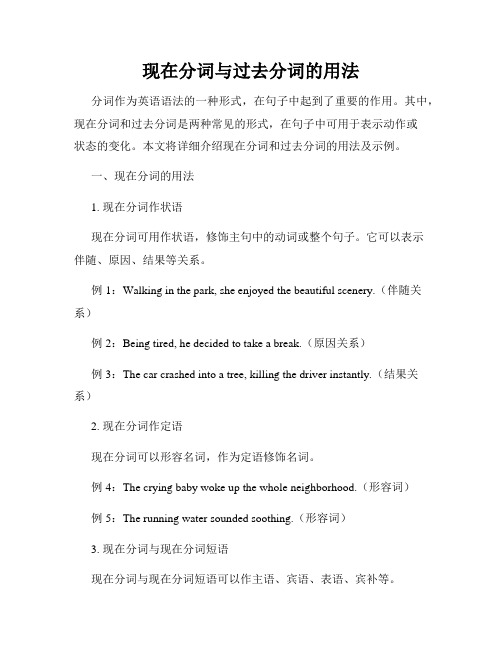
现在分词与过去分词的用法分词作为英语语法的一种形式,在句子中起到了重要的作用。
其中,现在分词和过去分词是两种常见的形式,在句子中可用于表示动作或状态的变化。
本文将详细介绍现在分词和过去分词的用法及示例。
一、现在分词的用法1. 现在分词作状语现在分词可用作状语,修饰主句中的动词或整个句子。
它可以表示伴随、原因、结果等关系。
例1:Walking in the park, she enjoyed the beautiful scenery.(伴随关系)例2:Being tired, he decided to take a break.(原因关系)例3:The car crashed into a tree, killing the driver instantly.(结果关系)2. 现在分词作定语现在分词可以形容名词,作为定语修饰名词。
例4:The crying baby woke up the whole neighborhood.(形容词)例5:The running water sounded soothing.(形容词)3. 现在分词与现在分词短语现在分词与现在分词短语可以作主语、宾语、表语、宾补等。
例6:Smiling is contagious.(主语)例7:I saw him playing basketball in the park.(宾语)例8:Her main duty is taking care of the patients.(表语)例9:They kept the fire burning all night.(宾补)二、过去分词的用法1. 过去分词作定语过去分词可以修饰名词,作为定语使用。
例10:The broken window has been fixed.(形容词)例11:I visited the abandoned house yesterday.(形容词)2. 过去分词与过去分词短语过去分词与过去分词短语可以用作被动语态、完成时态、副词等。
